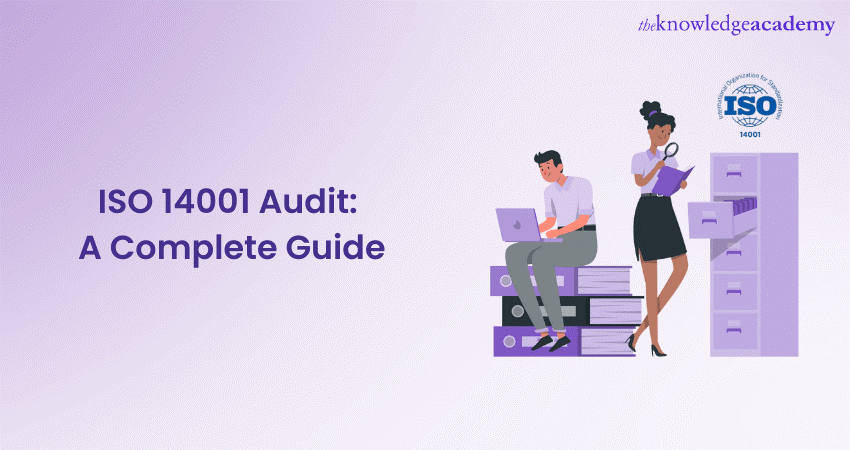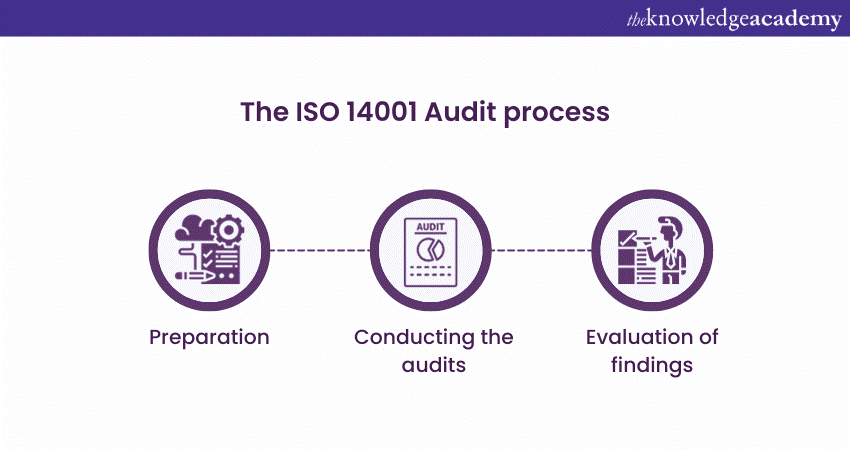We may not have the course you’re looking for. If you enquire or give us a call on 01344203999 and speak to our training experts, we may still be able to help with your training requirements.
Training Outcomes Within Your Budget!
We ensure quality, budget-alignment, and timely delivery by our expert instructors.

ISO 14001 Version 2004 vs 2015 is a globally recognised Environmental Management Systems (EMS) within the ISO 14001 Life Cycle. It presents a framework for organisations to implement effective environmental policies and procedures. In order to gain ISO 14001 Compliance, an audit is conducted to evaluate the organisation's conformity with the standard's requirements and to identify improvement opportunities. This blog will tell you all you need to know about the ISO 14001 Audit, including its benefits and will give you an overview of the auditing process. Read this blog to understand the ISO 14001 Audit, its different types, benefits, and the process for implementing an ISO 14001 Audit.
Table of Contents
1) Introduction to ISO 14001 Audit
2) What are the different types of ISO 14001 Audits?
3) Benefits of conducting the ISO 14001 Audit
4) The ISO 14001 Audit process
5) Conclusion
Introduction to ISO 14001 Audit
The ISO 14001 Audit deals with comprehensive evaluation, including ISO 14001 Document Control, of an organisation's Environmental Management System (EMS) to ensure compliance with the ISO 14001 Software considering the ISO 14001 Context of the organisation streamlines and enhances this comprehensive process encompassing the identification and consideration of both ISO 14001 Risks and Opportunities in environmental management. This audit assesses the organisation's environmental performance, identifies areas for improvement, and verifies compliance with legal and regulatory requirements related to Environmental Management.
Conducting regular ISO 14001 Audits is crucial for several reasons. Firstly, it helps organisations identify and address non-compliance issues before they escalate into major problems. Secondly, it ensures continual improvement in environmental performance and helps organisations stay up-to-date with evolving environmental regulations. Lastly, it enhances the organisation's reputation and credibility by demonstrating a commitment to sustainable practices.
What are the different types of ISO 14001 Audits?
There are two primary types of ISO 14001 Audits: Internal and External. These audits serve distinct purposes in the process of achieving ISO 14001 Certification. Here’s a brief overview on them:
ISO 14001 Internal Audits
The Internal Audit is conducted within the organisation as a form of self-examination of the implemented EMS. It plays a crucial role in preparing the EMS for the External Audit and eventual ISO 14001 Certification. The objectives of this audit include ensuring conformity with ISO 14001 Standards, evaluating the effectiveness of the EMS, and identifying areas that require improvement. Internal Audits within your organisation should adhere to formal, impartial, and objective processes.
ISO 9001 Auditors commonly employ checklists to record evidence, which aids in conducting consistent Audits and assessing the degree to which the processes align with the documented standards. The Audit process involves a thorough examination of how tasks and processes are executed in comparison to how they should be implemented according to established guidelines. Through this comparative analysis, areas in need of improvement can be identified. These observations should be meticulously recorded, and the results of the Audit should be reviewed at regular management meetings. Such meetings typically occur between one and four times a year, allowing organisations to make informed decisions and enhancements based on the Audit findings.
ISO 14001 External Audits
To attain ISO 14001 Certification, organisations must undergo an External Certification Audit. This Audit comprises two main stages. First, the certification body reviews the documentation related to the EMS. Subsequently, an on-site Audit is conducted to assess various aspects, including the results of Internal Audits, the management review process, and the corrective actions taken in response to the new EMS. Successful completion of this External Audit is the key to obtaining ISO 14001 Certification, demonstrating an organisation's commitment to environmental responsibility and compliance.
Want to drive sustainable change in your organisation? Sign up for our ISO 14001 Lead Auditor Course now!
Benefits of conducting ISO 14001 Audit
The benefits of conducting an ISO 14001 Audit are numerous and significant for organisations committed to Environmental Management and sustainability. By undergoing this thorough assessment, businesses can unlock various advantages that positively impact their operations, reputation, and overall success. The advantages are explained as follows:
1) Environmental performance improvement: An ISO 14001 Audit helps organisations improve their environmental practices by identifying areas for improvement, such as reducing waste and adopting sustainable processes.
2) Enhanced reputation and credibility: Regular ISO 14001 Audits demonstrate an organisation's commitment to environmental responsibility, enhancing its reputation and credibility among stakeholders.
3) Cost savings and increased efficiency: ISO 14001 Audits identify opportunities for cost savings and operational efficiency through waste reduction, resource conservation, and streamlined processes.
4) Legal and regulatory compliance: By ensuring compliance with environmental laws and regulations, ISO 14001 Audits help organisations avoid legal issues, penalties, and reputational damage.
5) Stakeholder engagement and customer satisfaction: ISO 14001 Certification obtained through Audits showcases an organisation's environmental commitment, leading to increased stakeholder engagement and customer satisfaction.
6) Employee engagement and motivation: Involving employees in environmental initiatives through ISO 14001 Audits boosts engagement, motivates them and gives them a sense of purpose in the workplace.
Take the first step towards ISO 14001 compliance with ISO 14001 Foundation Course. Sign up now!
The ISO 14001 Audit process
This section of the blog will elaborate on the stages of the Audit process:

Preparation
Before conducting an ISO 14001 Audit, organisations need to take several preparatory steps. This includes establishing an EMS tailored to their operations, identifying legal and regulatory requirements relevant to their industry, and conducting Internal Audits to assess compliance.
Conducting the Audits
To conduct an ISO 14001 Audit, organisations should select a qualified and independent Auditor who possesses the necessary expertise and experience. The Audit process typically involves document review, site visits, employee interviews, and the reporting of non-conformances.
Evaluation of findings
Once the ISO 14001 Audit is complete, the Auditor evaluates the findings and assesses the organisation's compliance with the standard. The Auditor identifies any non-conformances and works with the organisation to develop corrective actions. Continual improvement is an essential aspect of the ISO 14001 Audit process.
Conclusion
In conclusion, the ISO 14001 Audit is an essential tool for organisations seeking to manage their environmental impact effectively. It presents a structured approach to Environmental Management, promotes sustainability, and demonstrates a commitment to environmental responsibility. By adhering to the ISO 14001 Standard and conducting regular Audits, organisations can achieve excellence in Environmental Management and gain a competitive advantage.
Enhance your organisation’s Environmental Management practices with our comprehensive ISO 14001 Training. Register today!
Frequently Asked Questions
Upcoming Health & Safety Resources Batches & Dates
Date
 ISO 14001 Foundation Certification
ISO 14001 Foundation Certification
Mon 21st Oct 2024
Mon 6th Jan 2025
Mon 7th Apr 2025
Mon 4th Aug 2025
Mon 3rd Nov 2025







 Top Rated Course
Top Rated Course



 If you wish to make any changes to your course, please
If you wish to make any changes to your course, please


